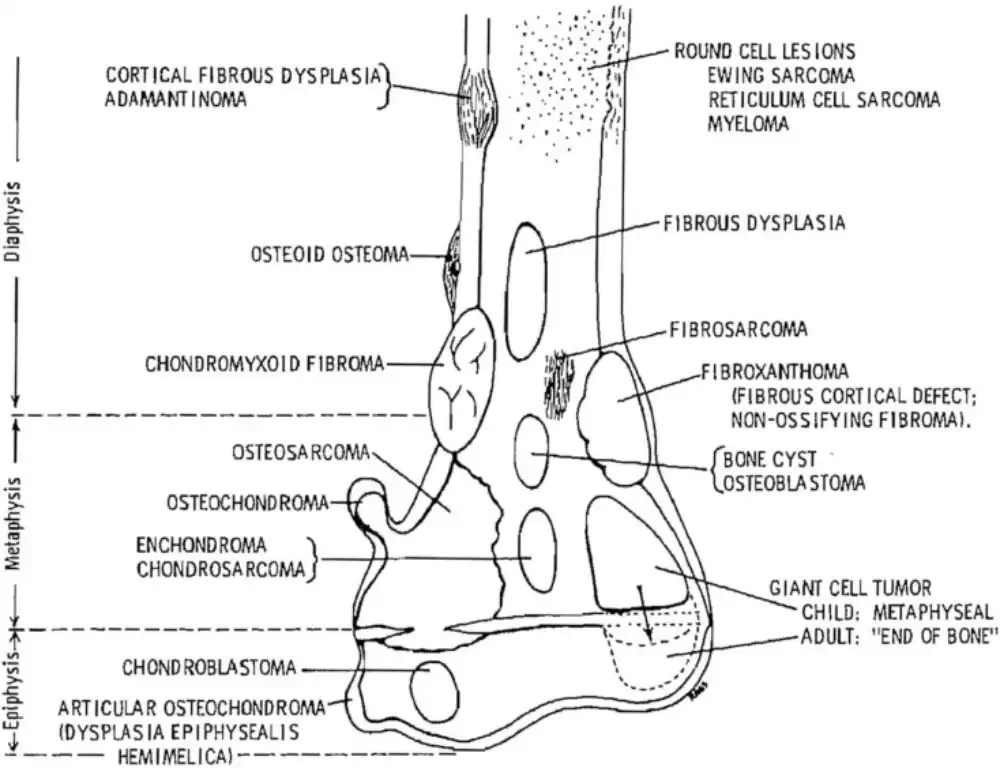Types of malignant bone cancers

Malignant bone tumors include:
Osteosarcoma
- It begins in bone cells and usually forms in the bones of the arms, legs, and pelvis.
- Osteosarcoma is more common in males than in females, and it often affects young people between 10 and 30 years old, but approximately 10% of cases grow and develop between the ages of 60 and 70, and it is rare in middle age.
Ewing’s sarcoma
- It is the second most common primary bone cancer, and the second most common cancer in children and adolescents.
- Most Ewing’s sarcomas grow in the bones, but they can start growing in other tissues and organs.
- The most common places for this cancer to be present are the pelvis and long bones such as the legs and arms, and it is rare for those over the age of 30.
Chondrosarcoma
- It occurs in people under the age of 20 years, while the risk of infection is higher in people over 40 years old. The incidence of Chondrosarcoma is equal in both sexes.
- This type of cancer grows in the pelvic bones, leg bones, and arm bones, and can sometimes grow in soft tissues.
- Chondrosarcoma is classified according to the degree, which measures the speed of its growth. The doctor classifies the degree after examining and diagnosing the cancerous tissue samples under the microscope. In the case of a lower degree and slower growth of cancer, the chance of the cancer spreading is less, and thus the cure rate is better.
Malignant fibrous histiocytoma
- More often this type begins in soft tissues such as ligaments, tendons, fat, and muscles compared to bone, and this cancer is polymorphic.
- When this tumor affects the bones, it usually affects the legs, around the knees, or the arms, and tends to grow rapidly and often spreads to other parts of the body.
- Malignant Fibrous Histiocytoma often affects middle-aged and elderly adults and is rare in children.
Fibrosarcoma
- It is another type of cancer that often grows in the soft tissues, affects the bones of the leg and arm, and usually affects middle-aged and elderly people.
Giant Cell Tumor of Bone
- This type of primary tumor is divided into two types, benign and malignant, and benign is the most common.
- Giant Cell Tumor of Bone usually affects the leg near the knees or arm bones in young and middle-aged people and does not often spread to other parts, but tend to return after surgery.
Chordoma
- It affects the bones of the spine or the base of the skull. This type of cancer is characterized by its slow growth and often does not spread to other parts of the body, but it often returns to grow in the same area if it is not completely removed.
- The spread is to the lymph nodes, lungs, and liver as they are among the most common areas for the growth of secondary tumors.
- Chordoma develops most often in adults over 30 years of age.
Non-Hodgkin Lymphoma
- It usually affects the lymph nodes, but sometimes it starts in the bones and often spreads due to the presence of lymph nodes in several parts of the body.
Multiple myeloma
- It is always found in the bones, but it is not considered a primary bone cancer because it begins to grow in the plasma cells of the bone marrow (the soft inner part of the bone).
- Although it destroys bones, it is considered leukemia rather than bone cancer, and it is treated as a widespread disease.
